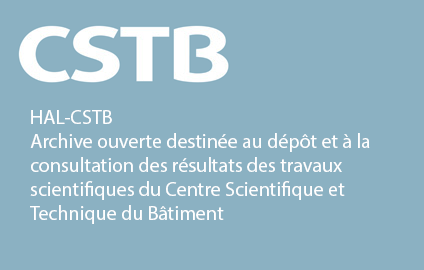Fire behavior of wood material : auto-ignition, degradation and auto-extinction
Comportement au feu du matériau bois : auto-inflammation, dégradation et auto-extinction
Résumé
The construction of positive energy and low carbon footprint buildings is a real response to the environmental issues and challenges of the coming decades. An increasing number of high-rise building construction projects made largely of wood are either under study or under construction. A key issue for the construction of such buildings is the fire behavior of these structures. Indeed, when the wood is subjected to a high heat flux, it will degrade and it can self-ignite. Conversely, in certain conditions, wood can self-extinguish. However, the bibliography shows the disparity concerning experimental results for a same material subjected to a given test such as the cone calorimeter. The results on the wood extinction remain limited in view of recent research carried out on this phenomenon. The aim of the thesis is to experimentally study the self-ignition, degradation and self-extinction of the wood material used in buildings. For this, many tests at different scales have been performed to examine the ability of the wood material to self-ignite or self-extinct under prescribed conditions. A total of 600 tests, were performed in vertical orientation and allowed to consolidate results with a statistical approach. A dedicated experimental setup has been deployed on each experimental device studied: an infrared camera providing to measure the surface temperature of the samples when they are subjected to a heat flux, two fast cameras (visible and infrared) in order to record the location and the auto-ignition mechanisms and very thin thermocouples embedded in the wood to measure the temperature evolution in the material according to fixed conditions. Results showed that for the auto-ignition (i.e. without pilot), the notion of ignition temperature of the material could be questionable when the ignition occurs at short times. Indeed, the flame appearance is, in most of the experiments, at a distance far from the exposed surface to the heat flux. The ignition mechanisms do not depend on the surface temperature but on the gas / air mixing conditions as well as the mixture temperature. The auto-ignition surface temperature makes therefore sense only for long auto-ignition times, for which ignition occurs close to the surface. The samples degradation depends on many factors: sample orientation, sample humidity, wood species, oxygen concentration in the atmosphere. The effect of these parameters was considered in this work. A particular attention was focused on the establishment of a metrology aimed at obtaining precise and accurate measurements. Very thin thermocouples, embedded in the sample and oriented parallel to the isotherms allow a better estimation of the temperature and were therefore used. Finally, a new experimental device based on two cones calorimeter arranged on a sliding table system was set up and made it possible to determine simple criteria for wood self-extinguishment at small scale.
La construction de bâtiments à énergie positive et à faible empreinte carbone constitue une véritable réponse aux enjeux et défis environnementaux de ces prochaines décennies. Un point clé pour la réalisation de tels bâtiments est le comportement au feu de ces ouvrages. En effet, lorsque le bois est soumis à une sollicitation thermique, celui-ci va se dégrader, voire même s’enflammer et, lorsque les conditions le permettent, s’éteindre. Cependant, l’état de l’art actuel met en évidence la disparité des résultats expérimentaux sur un même matériau soumis à un essai donné comme le cône calorimètre par exemple. L’objectif de la thèse présentée ici est d’appréhender expérimentalement l’auto-inflammation, la dégradation et l’auto-extinction du matériau bois utilisé dans les bâtiments. Pour cela, de nombreux essais à différentes échelles ont été effectués afin d’étudier la capacité du matériau bois à s’enflammer ou à s’éteindre de lui-même selon des conditions prescrites. Au total, 600 tests ont été effectués en orientation verticale et permettent de conforter les résultats avec une approche statistique. Une métrologie dédiée a été mise en place et a été déployée sur chaque dispositif expérimental étudié : une caméra infrarouge permettant d’obtenir la température de surface des échantillons lorsqu’ils sont soumis à une sollicitation thermique, deux caméras rapides (visible et infrarouge) pour filmer la localisation et les mécanismes d’auto-inflammation et des thermocouples très fins encastrés dans le bois de façon à mesurer l’évolution de la température dans le matériau selon des conditions fixées. Les travaux menés ont montré que pour l’auto-inflammation, la notion de température d’inflammation du matériau pouvait être discutable lorsque l’inflammation se produit à des temps courts. En effet, l’apparition de la flamme se situe alors, dans la majeure partie des expériences, à une distance éloignée de la surface exposée à la sollicitation thermique. Les mécanismes d'apparition de la flamme ne dépendent alors pas de la température de surface mais des conditions de mélange gaz/air ainsi que de la température de ce mélange. La température de surface à l'auto-inflammation n’a donc de sens que pour des temps d'auto-inflammation longs, pour lesquels l’inflammation se produit à proximité de la surface. La dégradation des échantillons dépend de nombreux facteurs. L’effet de certains de ces paramètres a été considéré dans ce travail. Une attention particulière a été portée sur la mise en place d’une métrologie visant à obtenir des mesures précises et fiables. Des thermocouples très fins, noyés dans l’échantillon et orientés parallèlement aux isothermes permettent une meilleure estimation de la température et ont donc été utilisés. Enfin, un nouveau dispositif expérimental basé sur deux cônes calorimètres disposés sur un système de table coulissante a été mis en place et a permis de déterminer des critères simples d’auto-extinction du bois à petite l’échelle.
| Origine | Fichiers produits par l'(les) auteur(s) |
|---|
Loading...
